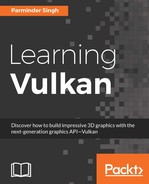- Learning Vulkan
- Learning Vulkan
- Credits
- About the Author
- Acknowledgments
- About the Reviewer
- www.PacktPub.com
- Preface
- 1. Getting Started with the NextGen 3D Graphics API
- 2. Your First Vulkan Pseudo Program
- Installing Vulkan
- The Hello World!!! pseudocode
- Initialization - a handshake with the device
- Swapchain initialization - querying the WSI extension
- Supplying shaders - shader compilation into SPIR-V
- Building layouts - descriptor and pipeline layouts
- Creating a Render Pass - defining a pass attribute
- Framebuffer - connect drawing images to the Render Pass
- Populating geometry - storing a vertex into GPU memory
- Pipeline state management - creating pipelines
- Executing the Render Pass - drawing Hello World!!!
- Queue submission and synchronization - sending jobs
- Displaying with presentation layer - rendering a triangle
- Fitting it all together
- Summary
- 3. Shaking Hands with the Device
- 4. Debugging in Vulkan
- 5. Command Buffer and Memory Management in Vulkan
- 6. Allocating Image Resources and Building a Swapchain with WSI
- Getting started with image resources
- Understanding image resources
- Memory allocation and binding image resources
- Introducing swapchains
- Understanding the swapchain implementation flow
- The swapchain implementation's class block diagram
- Renderer - a window management custom class
- VulkanSwapChain - the swapchain manager
- Creating the surface with WSI and associating it with the created window
- The graphics queue with present support
- Querying swapchain image formats
- Creating the swapchain
- Creating a depth image
- Summarizing the application flow
- Summary
- 7. Buffer Resource, Render Pass, Framebuffer, and Shaders with SPIR-V
- 8. Pipelines and Pipeline State Management
- Getting started with pipelines
- Caching pipeline objects with a PCO
- Creating a graphics pipeline
- Understanding compute pipelines
- Pipeline State Objects (PSO) in Vulkan
- Implementing the pipeline
- Summary
- 9. Drawing Objects
- Overview of the drawing process in Vulkan
- Preparing the drawing object
- Rendering the drawing object
- Rendering an indexed geometry
- Understanding synchronization primitives in Vulkan
- Resizing the display window
- Summary
- 10. Descriptors and Push Constant
- 11. Drawing Textures
- Image resource - a quick recap
- Prerequisites for texture drawing
- Implementing the image resource with linear tiling
- Implementing the image resource with optimal tiling
- Loading the image file
- Buffer object memory allocation and binding
- Populating the allocated device memory
- Creating the image object
- Image object memory allocation and binding
- Creating a command buffer object
- Setting the image layout
- Buffer to image copy
- Setting the optimal image layout
- Submitting the command buffer
- Creating an image sampler
- Creating the image view
- Copying data content between images and buffers
- Updating the descriptor set
- Summary
This chapter was full of image resources. We started with a basic understanding of image resource in Vulkan and learning about image objects, image layouts, and image views. Then we created image objects and allocated device memory to them. We also used WSI extensions to implement the swapchain and retrieved the swapchain images; these images were then associated with the presentation window. Finally, we created image views out of the swapchain images.
Next in this chapter, we implemented the depth buffer image. We also understood the different Vulkan image tilings and the basic difference between them. In addition to this, we also understood image layouts and their implementations using memory barriers.
In the next chapter, we will introduce the framebuffer and render pass. The framebuffer consumes the image views of a swapchain and depth image and associates them with a color and depth attachment. This information is then used by the render pass to define a unit of work. We will also learn about a buffer resource and use it to create the geometry buffer. In addition to this, we will look at SPIR-V to learn shader programming in Vulkan.
-
No Comment
